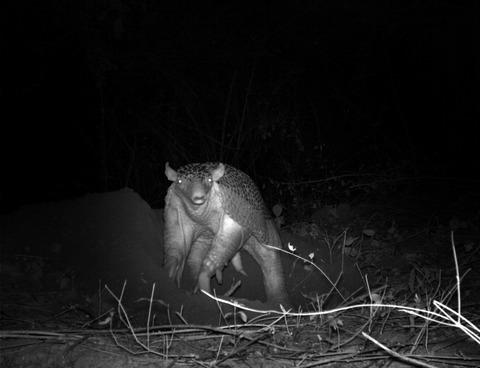Our official English website, www.x-mol.net, welcomes your feedback! (Note: you will need to create a separate account there.)
Excavations of giant armadillos alter environmental conditions and provide new resources for a range of animals
Journal of Zoology ( IF 2 ) Pub Date : 2020-05-29 , DOI: 10.1111/jzo.12782 Y. E. Di Blanco 1, 2, 3 , A. L. J. Desbiez 4, 5 , D. di Francescantonio 1, 2 , M. S. Di Bitetti 1, 2, 3
Journal of Zoology ( IF 2 ) Pub Date : 2020-05-29 , DOI: 10.1111/jzo.12782 Y. E. Di Blanco 1, 2, 3 , A. L. J. Desbiez 4, 5 , D. di Francescantonio 1, 2 , M. S. Di Bitetti 1, 2, 3
Affiliation

|
Burrowing species can be considered important ecosystem engineers that increase landscape heterogeneity, create subterranean shelters and provide foraging opportunities. We measured and described different aspects of giant armadillo (Priodontes maximus) excavations (size, age), and differences generated in relation to the surrounding environment (vegetation, humidity, temperature) in three sites of the Argentine Chaco Region. We used camera‐traps in two protected areas to monitor the use of burrows by other species and tested two primary and non‐mutually exclusive hypotheses: Giant armadillo burrows are used as thermal protection from temperature extremes and provide new foraging opportunities for other species. Greater litter cover and depth were recorded in giant armadillo burrows, and more bare ground in spoil piles, producing habitat heterogeneity. Burrows had higher humidity and more moderate temperatures, with lower temperatures during hot months and higher temperatures during cold months. Out of 48 vertebrate species recorded by camera‐traps, 27 taxa (17 mammals, 9 birds and one reptile) were recorded using burrows. White‐lipped peccaries (Tayassu peccari) and collared peccaries (Pecari tajacu) used burrows more frequently than other mammals. Medium‐sized carnivores such as Pampas fox (Lycalopex gymnocercus) and Geoffroy´s cat (Leopardus geoffroyii) tended to only investigate burrows, probably searching for prey. In no instances, animals other than giant armadillos were recorded staying inside burrows for more than a few seconds. Medium‐sized species interacted more frequently than large‐sized species, and smaller species used giant armadillo burrows less than larger ones, suggesting that the benefits provided by excavations to other species depend on their body weight. The probability of use of burrows decreases with time, suggesting that burrows provide a finite resource used opportunistically. Further reduction in the distribution of the giant armadillo is therefore likely to have effects on habitat heterogeneity and biodiversity, probably impacting the fitness of species that use their burrows as foraging sources.
中文翻译:

挖掘大型犰狳会改变环境条件,并为一系列动物提供新资源
穴居物种可以被视为重要的生态系统工程师,可以增加景观的异质性,创建地下庇护所并提供觅食机会。我们测量并描述了巨型犰狳(Priodontes maximus)发掘(大小,年龄),以及在阿根廷Chaco地区三个地点相对于周围环境(植被,湿度,温度)产生的差异。我们在两个保护区中使用了相机陷阱来监视其他物种对洞穴的使用,并测试了两个主要的和非互斥的假设:巨型犰狳洞穴被用作极端温度的热保护,并为其他物种提供了新的觅食机会。巨大的犰狳洞穴记录了更高的凋落物覆盖度和深度,而弃土堆中的裸露地面也更多,从而产生了栖息地异质性。洞穴的湿度较高,温度较适中,炎热月份温度较低,寒冷月份温度较高。相机陷阱记录的48种脊椎动物中,有27种(17种哺乳动物,用洞穴记录了9只鸟和1只爬行动物。白唇野猪(Tayassu peccari和衣领野猪(Pecari tajacu)比其他哺乳动物更经常使用洞穴。中型食肉动物,例如南美大草原狐狸(Lycalopex Gymnocercus)和杰弗罗伊的猫(Leopardus geoffroyii))倾向于只调查洞穴,可能在寻找猎物。在任何情况下,都没有记录到巨型犰狳以外的动物在洞穴内停留的时间超过几秒钟。中型物种比大型物种的相互作用更频繁,而较小的物种使用巨型犰狳洞穴要比大型物种少,这表明发掘给其他物种的收益取决于它们的体重。使用洞穴的可能性随时间降低,这表明洞穴提供了机会性使用的有限资源。因此,进一步减少巨型犰狳的分布可能会影响栖息地的异质性和生物多样性,可能会影响利用其洞穴作为觅食来源的物种的适应性。
更新日期:2020-05-29
中文翻译:

挖掘大型犰狳会改变环境条件,并为一系列动物提供新资源
穴居物种可以被视为重要的生态系统工程师,可以增加景观的异质性,创建地下庇护所并提供觅食机会。我们测量并描述了巨型犰狳(Priodontes maximus)发掘(大小,年龄),以及在阿根廷Chaco地区三个地点相对于周围环境(植被,湿度,温度)产生的差异。我们在两个保护区中使用了相机陷阱来监视其他物种对洞穴的使用,并测试了两个主要的和非互斥的假设:巨型犰狳洞穴被用作极端温度的热保护,并为其他物种提供了新的觅食机会。巨大的犰狳洞穴记录了更高的凋落物覆盖度和深度,而弃土堆中的裸露地面也更多,从而产生了栖息地异质性。洞穴的湿度较高,温度较适中,炎热月份温度较低,寒冷月份温度较高。相机陷阱记录的48种脊椎动物中,有27种(17种哺乳动物,用洞穴记录了9只鸟和1只爬行动物。白唇野猪(Tayassu peccari和衣领野猪(Pecari tajacu)比其他哺乳动物更经常使用洞穴。中型食肉动物,例如南美大草原狐狸(Lycalopex Gymnocercus)和杰弗罗伊的猫(Leopardus geoffroyii))倾向于只调查洞穴,可能在寻找猎物。在任何情况下,都没有记录到巨型犰狳以外的动物在洞穴内停留的时间超过几秒钟。中型物种比大型物种的相互作用更频繁,而较小的物种使用巨型犰狳洞穴要比大型物种少,这表明发掘给其他物种的收益取决于它们的体重。使用洞穴的可能性随时间降低,这表明洞穴提供了机会性使用的有限资源。因此,进一步减少巨型犰狳的分布可能会影响栖息地的异质性和生物多样性,可能会影响利用其洞穴作为觅食来源的物种的适应性。


























 京公网安备 11010802027423号
京公网安备 11010802027423号